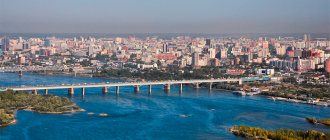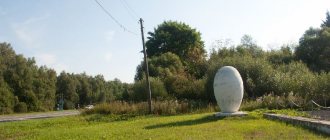City in Moscow region, Russia
| Volokolamsk Volokolamsk | |
| Town[1] | |
| View of the Volokolamsk Kremlin | |
| Flag Coat of arms | |
| Location Volokolamsk | |
| Volokolamsk Location Volokolamsk Show map of Russia Volokolamsk Volokolamsk (Moscow region) Show map of the Moscow region | |
| Coordinates: 56°02′N 35°57'E / 56.033°N W. 35.950 ° E. / 56.033; 35.950Coordinates: 56°02′N 35°57'E / 56.033°N W. 35.950 ° E. / 56.033; 35.950 | |
| A country | Russia |
| Federal subject | Moscow region[1] |
| Administrative region | Volokolamsk district[1] |
| Town | Volokolamsk[1] |
| First mention | 1135[2] |
| Height | 170 m (560 ft) |
| population (2010 Census)[3] | |
| • General | 23,433 |
| • Evaluate (2018)[4] | 19,824 (-15.4%) |
| Administrative status | |
| • Capital from | Volokolamsk district[1], Volokolamsk[1] |
| Municipal status | |
| • Municipal district | Volokolamsk municipal district[5] |
| • Urban village | Volokolamsk urban settlement[5] |
| • Capital from | Volokolamsk municipal district[5], Volokolamsk town[5] |
| Timezone | UTC + 3 (MSK [6]) |
| Postal code(s)[7] | 143600, 143602–143604, 143608 |
| Dial code(s) | +7 49636 |
| OKTMO I WOULD | 46605101001 |
Volokolamsk
(Russian: Volokolamsk) is a town and administrative center of Volokolamsk District in Moscow Oblast, Russia, located on the Gorodenka River, near its confluence with the Lama River, 129 km (80 mi) northwest of Moscow. Population: 23,433 (2010 Census);[3]16,656 (2002 Census);[8]18,226 (1989 Census).[9]
Story
It was first mentioned in the Resurrection Chronicle in 1135.[2] It was built by Novgorod traders on a 5-kilometre (3.1 mi) portage (Russian: Volok) on the waterway from Novgorod to Moscow and Ryazan, hence the name "Volokolamsk" (i.e. "Volok on the Lama"). In 1178 the city was burned by Vsevolod the Big Nest, who added it to the Vladimir-Suzdal land. His son Yaroslav II restored it in Novgorod in 1231. The Mongol invasion of Rus', the city was divided into two parts: one was assigned to Novgorod, and the other to the Grand Dukes. Vladimir. The Principality of Tver failed to take it in 1273.
Ivan Kalita presented his part of the city to the boyar Rodion Nestorovich, who has now wrested another part from Novgorod. In 1345, Simeon the Proud transferred Volokolamsk to his father-in-law, one of the Smolensk princes. While in the possession of Smolensk, the city withstood the siege. Algirdas during the Lithuanian-Muscovite War (1368–1372). Vladimir the Bold was defeated by Tokhtamysh near Volokolamsk in 1383. Soon he returned to Novgorod. The city remained the southernmost enclave of the Novgorod Republic until 1398, when Vasily I finally included it in the Grand Duchy of Moscow. Ten years later it was granted for two years to Švitrigaila, who had just moved to Moscow. Having lost the Hanseatic Trade and connections with Novgorod, the city fell into decay and was not mentioned in any sources for the next half century. It was in 1462, when Volokolamsk handed over to Ivan III to his younger brother, that the city became the center of a full-fledged principality. Its first prince built the one-domed Limestone Cathedral of the Resurrection, which still stands today. Another prince was Andrei Volotsky; the main monument of his reign is the three-domed cathedral of the Vyazmishchi monastery (1535).
The Resurrection Cathedral, built in the 1460s, is one of the last limestone cathedrals in Russia
In 1613, Volokolamsk withstood the siege. Sigismund III Vasa, an event that led to the city's fortifications being depicted on his coat of arms. By that time, Volokolamsk was associated primarily with the Joseph-Volokolamsk Monastery, located 17 km to the northeast.
Soviet power in Volokolamsk was established at the end of October 1917. World War II, a series of violent clashes between German and Soviet troops and partisans took place near Volokolamsk. The city was under German occupation from October 27 to December 20, 1941, when the 331st Infantry Division was liberated.
Demographic catastrophe of Volokolamsk
In the Central Federal District, all regions are dying out, except Moscow and the Moscow region.
However, not everything is so rosy in the Moscow region either. Population growth occurs not so much due to the birth rate, but due to the influx of migrants. But there are extremely depressed areas in the Moscow region, where even the migration factor cannot compensate for the population decline. For example, our Volokolamsk region has been rapidly dying out for several years in a row. Over the last 9 years alone, from 2009 to 2018, the population of the district decreased from 56,612 to 41,496 people, that is, despite the births, the total number decreased by 15,116 residents. Recently, the Volokolamsk Week newspaper prepared and published a visual infographic on this topic:
There are, of course, many reasons that led to such terrible statistics, but one of the most important reasons is the poor quality of our healthcare.
The most numerous causes of death in Volokolamsk residents are cardiovascular diseases and cancer. There is no doubt that it is in this direction that medical care in Volokolamsk needs to be especially carefully developed. However, these are the areas that are the least developed in our country. For a long time, in the Volokolamsk Central District Hospital, specialized specialists in oncology and cardiology were simply absent as a species. Patients were cared for by regular therapists.
Now the situation has begun to change a little. Recently, our hospital even opened a primary vascular department (PVD), specialized specialists appeared, but at this point development practically stalled.
The department does not have modern diagnostics, there is no magnetic resonance imaging (MRI) and computed tomography (CT) equipment, there is no daily Holter ECG monitoring, and so on. The quality of medical services is therefore extremely low.
I was able to talk about these issues with the Deputy Minister of Health of the Moscow Region, Irina Gennadievna Soldatova, first at the conference of the All-Russian Popular Front held in Moscow on February 21, 2022.
The conversation with her turned out to be very lively and it took place on the sidelines of the thematic site of the ONF conference on demography.
As a result, Irina Gennadievna suggested continuing our conversation, but in more detail at the upcoming Forum “Strong. Healthy. Clean”, where she promised to come and which ultimately took place on March 1 in Volokolamsk.
Usually, I am not delighted with such forums; they always contain a lot of pathos and empty ideas. These events are done to promote the next doctrine of the leader, and not for a real discussion of problems. However, I decided to take advantage of the situation to convey my proposals.
This time, the new program of the governor of the Moscow region “New Five-Year Plan” was presented and there was practically no time for urgent conversations with officials. Nevertheless, I managed to speak at the forum and convey the public’s opinion in which direction cardiology should be developed in Volokolamsk.
In response, Deputy Minister of Health Irina Soldatova promised to resolve this year the issue of supplying our Central District Hospital with the latest MRI equipment, as well as to achieve the provision of a very important medical service - coronary angiography. The head physician of the Central District Hospital, Angela Magomedova, in turn, said that they are ready to purchase equipment for computed tomography.
I would like to believe that our common efforts will make a difference.
In popular culture
Alexandra Bek's 1944 novel Volokolamsk Shosse ("Volokolamskoe Shosse"), is a slightly fictionalized account of defensive battles involving elements of the 316th Rifle Division on the road from Volokolamsk to Moscow in October 1941.
The online game Thunder of War (where one controls Armored Vehicles such as Tanks) features a map of ground forces called "Volokolamsk" and a larger version called "Volokolamsk Surroundings". Players deride the map as being too open and too big. [eleven]
Volokolamsk is a city of military glory during the Patriotic War.
The important military-strategic location of Volokolamsk further influenced the course of the history of the Russian state. The city stood in the way of the enemy many times, defending the Fatherland. This happened during the War of 1812; the same heroic city is inscribed in the annals of the Great Patriotic War of 1941-1945. Thousands of city residents volunteered for the front in the first days of the fighting. Volokogorod residents who remained in the city joined construction battalions that carried out work on the construction of defensive communications - pillboxes, bunkers, anti-tank ditches, forest rubble.
During the most difficult period of the defense of Moscow, Volokolamsk was on the line of fierce battles. Hitler's command considered it a priority to capture the key Volokolamsk fortified area, since a breakthrough of the defense in this place opened up the northwestern direction of movement to Moscow. The commander of the Western Front at that time, Army General G.K. Zhukov, entrusted the defense of Volokolamsk to the 16th Army, led by Lieutenant General K.K. Rokossovsky.
On October 16, 1941, heavy, fierce fighting broke out in the Volokolamsk direction. The Nazi invaders planned to break through to the Volokolamsk Highway at lightning speed at any cost and move towards Moscow. The soldiers of the Panfilov division stood in their way as an insurmountable obstacle, holding back the advance of an enemy many times superior in strength. On October 27, 1941, after the Nazi command decided to introduce reserve forces into battle, the enemy managed to capture the city. The day of November 16, 1941, when fascist German troops launched a new offensive on Moscow, went down in the history of the Great Patriotic War as the day of unforgettable heroism of 28 soldiers of the Panfilov division in the defense of the Volokolamsk highway.
There was a fierce battle with the enemy for 32 days. Despite superior forces in manpower and equipment, the invaders failed to quickly overcome the defense line in the Volokolamsk direction and break through to Moscow. With the arrival of winter, in early December 1941, Soviet troops launched a counteroffensive, and on December 20, Volokolamsk was liberated from the Nazi aggressors.
In 2010, Volokolamsk was awarded the title “City of Military Glory” for the courage and perseverance shown by its residents in defending the Fatherland during the most difficult period of the Great Patriotic War.
|
|
|
Recommendations
Notes
- ^ a b c d f g gram hour
Resolution No. 123-PG - ^ a b Encyclopedia of Russian Cities
. Moscow: Great Russian Encyclopedia. 2003. p. 89. ISBN 5-7107-7399-9. - ^ a b
Federal State Statistics Service of Russia (2011).
“All-Russian Population Census 2010. Volume 1" [All-Russian Population Census 2010, vol. 1]. All-Russian Population Census 2010 [All-Russian Population Census 2010]
(in Russian). Federal State Statistics Service. - "26. The size of the permanent population of the Russian Federation by municipalities as of January 1, 2022.” Federal State Statistics Service. Retrieved January 23, 2022.
- ^ a b c d f
Law No. 1/2005-OZ - "On the calculation of time." Official Internet portal of legal information
(in Russian). June 3, 2011. Retrieved January 19, 2022. - Post office. Information and computing center of OASU RPO. ( Post office
).
Search for postal facilities ( Search for postal facilities
) (in Russian) - Federal State Statistics Service of Russia (May 21, 2004). “The population of Russia, the constituent entities of the Russian Federation as part of federal districts, urban settlements, urban settlements, settlements, settlements of 3 thousand or more people.” [Population of Russia, its federal districts, federal subjects, districts, urban settlements, rural settlements - administrative centers, rural settlements with a population of more than 3000 people] (XLS). All-Russian Population Census of 2002 [All-Russian Population Census of 2002]
(in Russian). - “All-Union Population Census of 1989. The actual population of union and autonomous republics, autonomous regions and districts, territories, regions, urban settlements and villages. Information Bulletin of the Moscow Region,” No. 10, October 30, 2010 (Governor of the Moscow Region. Resolution dated 28 September 2010 No. 123-PG On cadastral data of administrative-territorial and territorial units of the Moscow Region
As amended by Resolution No. 252-PG dated June 26, 2015
On amendments to the inventory data of administrative-territorial units of the Moscow Region
. - Moscow Regional Duma. Law No. 1 / 2005-OZ of January 11, 2005 “On the status and boundaries of the Volokolamsk municipal district and newly formed municipalities within it,” as amended. Law No. 127 / 2010-OZ of October 29, 2010 “On amendments to the Law of the Moscow Region “On the status and boundaries of the Volokolamsk municipal district and newly formed municipalities within it””. Came into force on the date of official publication. Published: “Daily News. Moscow Region", No. 20, February 4, 2005 (Moscow Regional Duma. Law No. 1/2005-OZ of January 11, 2005. On the status and boundaries of the Volokolamsk municipal district and the newly formed municipalities included in its composition.
As amended by the Law dated 29.10 .2010 No. 127/2010-OZ.
On amendments to the Law of the Moscow Region “On the status and boundaries of the Volokolamsk municipal district and the newly formed municipalities within it
.” Valid from the date of official publication.).
Education
The following educational institutions are located in the city:
- Volokolamsk branch of Moscow State University of Technology and Management
- Volokolamsk Institute of Hospitality - branch of the Russian International Academy of Tourism
- Branch of the Moscow State Open University in Volokolamsk
- Russian New University, Volokolamsk branch
- Branch of Moscow State Regional University in Volokolamsk
- Gymnasium, several schools
- Volokolamsk College of Law, Economics and Security (formerly Volokolamsk College of Economics and Law)





